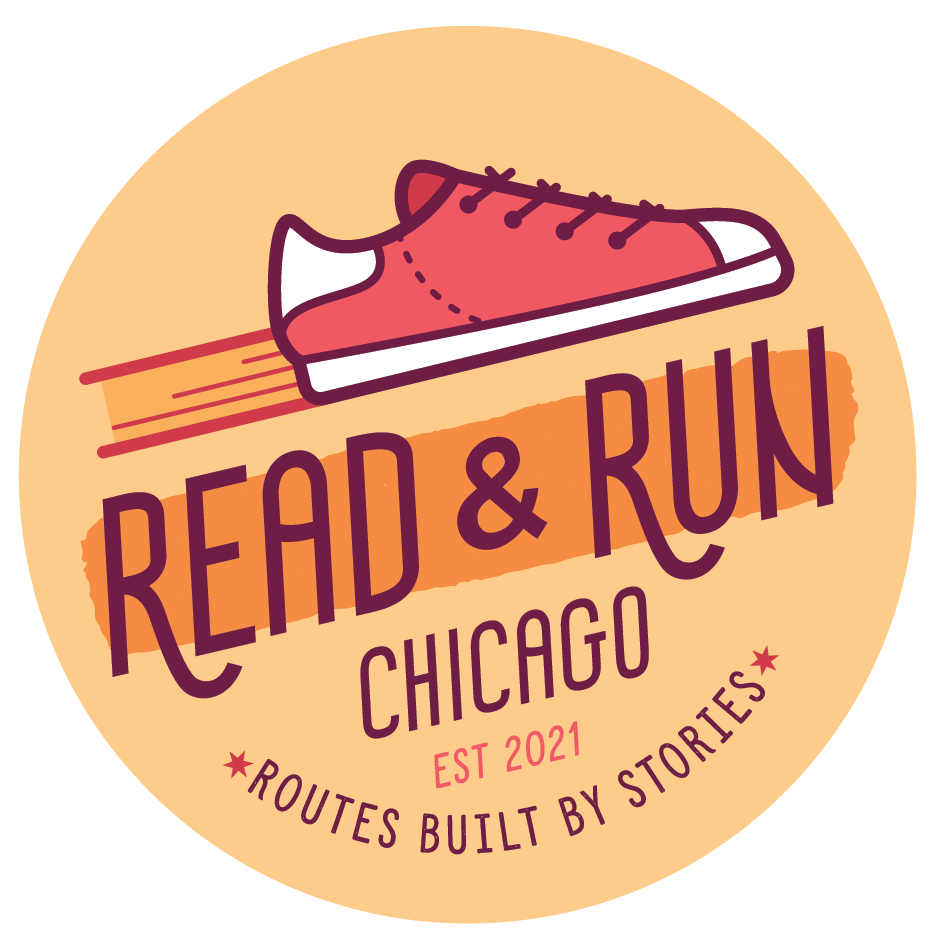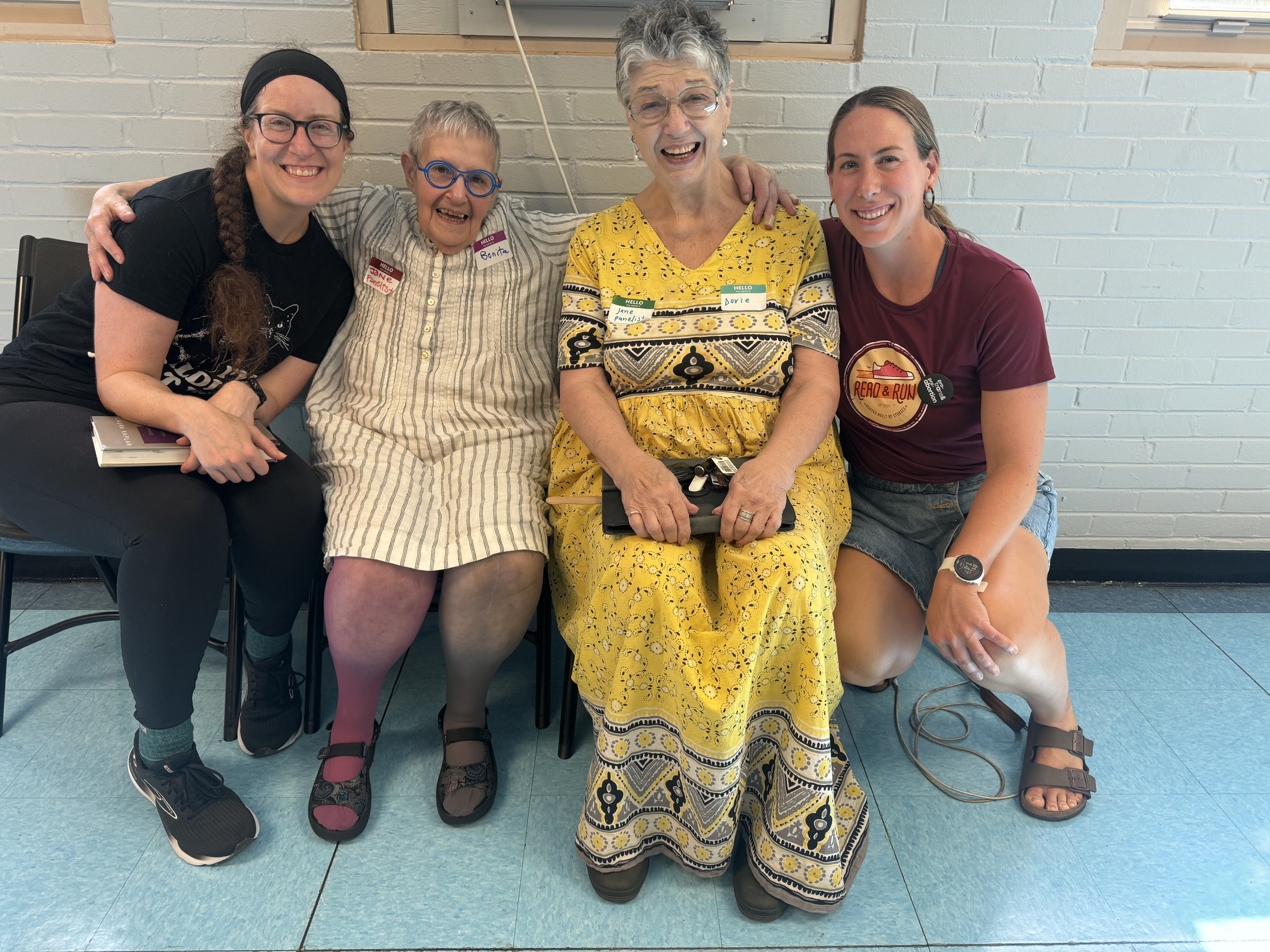Historical Context of Jane, Plus Contemporary Resources
NOTE: Guide Kaylee Tock led readers & runners on a four-mile Running Tour in September 2024 inspired by the work of Jane, an underground abortion counseling service that functioned in Chicago from 1969-1973. At the end of our route, we met Dorie Barren and Benita Greenfield, two former Janes. Kaylee wrote this blog post to recap the event and provide additional historical context and information to keep learning more.
Readers & runners in Hyde Park during our September 2024 Running Tour of the Jane Collective.
Here’s a brief recap of what Jane was:
Jane (1969-1973) referred to themselves and their work as a Service.
At their core, Janes were interested in shifting power dynamics. They believed pregnant people should have and make their own choices (not depend on a man or system to choose for them).
While Jane provided abortion counseling, this was a far cry from the 48 hour waiting period Americans can face when scheduling an abortion today. Rather than the current negative connotation (surely you’ll change your mind, you potentially hysterical person who isn’t thinking through the consequences!), Jane’s counseling was often the first time a person with a uterus was ever given real medical information about their body.
They operated all over Chicago, first using outside abortion services (which inevitably involved blindfolds), then training their own members to perform abortions and other medical procedures themselves.
Once they were relying on themselves, they operated without blindfolds, using a network of ever-changing houses and apartments called Fronts and Places.The Front was the “waiting room”, where family or friends could join the pregnant person while they waited for services.
The Place was the location where procedures themselves were performed, often miles away from the Front.Janes would switch off who drove between the two locations, and would also switch off whose cars were used.
May 3, 1972, someone requested the police stop their sister-in-law from having an abortion. This was the first and only time the police took action against Jane.
There were several other groups doing related work. While the Janes were busy in Chicago…
Meanwhile, in Boston: A group of women met in 1969 and formed a collective dedicated to helping demystify women’s health. Their 1970 publication, Our Bodies, Ourselves, was referenced a number of times in Kaplan’s The Story of Jane - and was revised 9 times through 2011. This book has been instrumental in helping multiple generations of women find power through knowledge of their bodies; it was so groundbreaking, Jane often shared copies with the people who came for services. (Read more about the Boston Women’s Health Book Collective! Or just click and scroll to enjoy the picture of Raggedy Ann!)
And on the west coast, in Los Angeles: Carol Downer and Lorraine Rothman were getting into the self-examination side of women’s health. If you read Kaplan’s The Story of Jane, you’ll remember these two stopped in Chicago on their cross-country tour (organized by the nationwide group, NOW) to demonstrate their speculum + mirror technique. (Hear Carol talk about that here.) In LA, they founded the Women’s Abortion Referral Service (after having already started the Los Angeles Abortion Task Force, a subset of the local chapter of NOW). This LA service was offering pregnancy screening and referrals for safe abortions (though you might also remember Carol and Lorraine were the two who suggested the cannula (vacuum) abortion could be self-performed).
And closer to home, in Bloomington, IN: The Midwest Abortion Counseling Services was a campus-based counseling service that sent many people to Jane. Their origin story was similar - the founder, Ruth Mahaney, was a grad student who had a friend who needed an abortion, and the options were dismal. They remained much smaller, though - Ruth’s number was used on the fliers; even when she left the University, students were still looking up “Ruth Mahaney” in the phonebook if they wanted an abortion.
We can see parallels today (sadly) - NOW is still in existence, and we have a TON of new groups across the country that either provide or direct people toward safe services. Contraception is still overly complicated to receive, and abortion is solidly in the hands of medical providers (and politicians).
Are you thinking that maybe the people directly impacted should have autonomy? Great! Here are some further resources for you: (get involved however you want! Keep reading! Organize! Advocate! It’s up to you. Just don’t be complacent!)
Left to Right: Kaylee Tock, Benita Greenfield, Dorie Barren, and Allison Yates.
Read:
Invisible Women: Data Bias in a World Designed for Men - Caroline Criado Perez
Fun fact: US gov doesn’t fund research into women’s health issues - in fact, of all common cancers, only cervical and uterine have had a *decrease* in 5 yr survival rates since 1970 (pretty similar in the UK, btw – our abysmal maternity care is basically the same as theirs). Only read this book if you want to get REALLY ANGRY and start seeing more disparities in literally every aspect of society. (Please read this. It’s incredible.)
The 2024 KFF Women’s Health Survey has recent stats on attitudes toward reproductive rights. One that I find really sad: Among women who say they have ever wanted or needed an abortion, 15% (2% of all reproductive age women) report that at some point in their lives, they have wanted or needed an abortion that they did not get. (Digging into that, over a third said the barrier was “access”.)
Take action:
VOTE. (Let me reiterate that.) The reason we have judges in the Supreme Court is because people voted for them in the local races. (Injustice Watch & Ballotpedia are both helpful voter prep tools.)
Keep up with the policies. Guttmacher continually updates a national abortion policy map. In conjunction with GovTrack.us, this can help you decide where to focus your efforts.
Support. Midwest Access Project, a 501(c)(3) created to ensure providers have the training they need to offer full-service reproductive and sexual healthcare, has a SUPER extensive “allies” list. It’s like a curated Google result for “midwest abortion nonprofit” (though there are national groups on here, too!).
Organize. If you think there’s an unmet need, consider what needs to be done and make a plan to do it. Here’s a curated set of organizing resources from Heather Booth, compiled when her documentary came out. (Refresher: Heather was the one to organize Jane, but left once she had enough people in place to run the service smoothly. She has spent her lifetime organizing and helping people organize for social justice.)
Kaylee on the September 2024 Running Tour.
One other, general note - volunteering your time directly with an abortion-adjacent org is pretty difficult right now, simply because they are a) overwhelmed with demand for services and have limited resources for volunteer training, and b) overwhelmed by support after 2022’s overturning of Roe v. Wade.
Planned Parenthood still has the capacity to train volunteers!
Chicago Women’s Health Center has a variety of volunteer opportunities (not necessarily abortion-specific).
More on Jane:
A documentary from 1996: Jane: An Abortion Service (note: I haven’t watched this yet!)
A story from UChicago from winter 2023 in conjunction with their screening of The Janes - read more about the screening and some interviews with former Janes.
WBEZ did a piece in August 2022 with some current pics of the main places from 1972.
If you’re looking for a concise history to share with someone else, Chicago Mag has a great 2019 article.
Run a Self-Guided Route
And finally: A Self-Guided Route from both the Front and the Place that were used on the day of the Janes arrest on May 3, 1972.
Start: 5532 S Everett (the Front)| End: 7251 South Shore (the Place)




